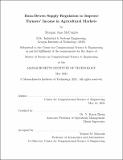Data-Driven Supply Regulation to Improve Farmers’ Income in Agricultural Markets
Author(s)
McCombs, Morgan Jane
DownloadThesis PDF (46.87Mb)
Advisor
Zheng, Y. Karen
Terms of use
Metadata
Show full item recordAbstract
Millions of smallholder farmers live in persistent poverty. To improve farmers’ livelihood and connect physically distant markets, the Karnataka state government in India launched the Unified Market Platform (UMP) in 2014. The UMP is an online agri-platform used to facilitate commodity auction markets. In this research we assume the role of the state government and propose to regulate the daily auction supply for sale under the objectives of increasing farmers’ revenue and reducing day-to-day price fluctuation. Using data collected via the UMP, we estimate a model on the relationship between market supply, demand, and realized daily price, then employ Dynamic Programming (DP) to determine the government’s optimal inventory control policy. We characterize the optimal solution and revenue, and how the supply and price model parameters affect the solution. We first consider a benchmark, deterministic formulation, then model extensions that incorporate inventory holding cost and stochastic demand. In the deterministic setting, supply regulation yields an average annual revenue improvement of 0.1%-4.3%; price variance is reduced by an average of 34%-99%. Comparable results are achieved with the model extensions across most commodities and markets. We conclude there is significant benefit to implementing an inventory regulation scheme.
With the prospect of further improving farmers’ revenue, we also consider the combinatorial problem of merging two or more markets. To gain structural insights, we first analyze the special case of potentially merging two identical markets. The theoretical results indicate that merging is optimal if the difference between daily supply quantities is relatively small and the supply quantities are initially small. Using UMP data, our counterfactual empirical analysis shows that merging markets yields additional revenue gains of 0.3%-3.8%. Finally, we numerically analyze potential revenue gains when merging actual markets from the UMP data. Most analyses yield comparable results, however certain settings produce mixed results for different parameters.
Date issued
2021-06Department
Massachusetts Institute of Technology. Center for Computational Science and EngineeringPublisher
Massachusetts Institute of Technology